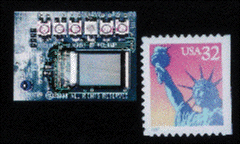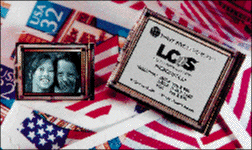Microdisplays go high res
Smaller displays with quality images are poised
to empower handheld devices
The strong demand for high information content in the next generation of portable electronics will require the use of small displays capable of high-resolution imagery. Very small displays, commonly referred to as microdisplays, promise to fulfill that requirement.
With the next generation of personal electronics becoming more complex multipurpose devices, new display technologies are becoming necessary. Three companies are among those addressing the emerging need.
MicroDisplay (San Pablo, CA) has developed an “intelligent” miniature display with integrated VGA and NTSC decoding circuitry in the CMOS backplane. The MTV640G1 die includes digital scan circuitry that allows images to be displayed at high frame rates. The device has a 5-V operating voltage and a VGA resolution of 640 x 480. The LCD operates in the reflective active-matrix mode.

Fig. 1. MicroDisplay's MTV640G1 miniature display
is shown here packaged on a fiber-glass display carrier,
which is necessary only to provide a connection to the video
chip.
chip.
The display die has an active-area diagonal of 12.6 mm and measures under 9 x 13 mm. The total chip-scale package is not much larger than a postage stamp (see Fig. 1 ). By eliminating the external electronics, this system-on-a-chip display consumes up to 10 times less power (approximately 200 mW) than a display requiring external circuitry.
Three-Five Systems (Tempe, AZ) has begun developing the OptiScape I Microdisplay Imaging System, which has a sequential color SVGA digital backplane and 12-mm diagonal display (see Fig. 2 ). Using proprietary reflective silicon-on-glass technology operating in either projection or virtual modes, it has a contrast ratio greater than 200:1. The display has a pixel pitch of 12 µm, with a 72-Hz frame rate.

Fig. 2. Three-Five System's microdisplay uses liquid crystal-on-silicon,
a reflective silicon-on-glass technology that operates in either projection
or virtual modes and currently provides SVGA or SXGA resolution.
The device has a user-selectable “power-miser” mode, and is designed as a computer memory component that maintains its image without external refresh circuits. The result is a power consumption that is lower by a factor of 10 (less than 100 mW) than that of an equivalent high-resolution display. An SXGA version, drawing less than 250 mW, is also in development.
Last year, Kopin (Taunton, MA) made a monochrome microdisplay that won a Product of the Year award (see Electronic Products , January, p. 37). The company now makes the CyberDisplay 320C, a transmissive 320 x 240 active-matrix LCD with 76,800 full-color pixels. The display system uses a field color sequential technique to provide full color in every pixel (no subpixels). The 0.24-in.-diagonal backlit LED consumes 80 mW at 22 fL, through the magnifying view lens.
For more information from MicroDisplay, contact Stephanie Silman at 510-243-9515, ext. 133, visit http://www.microdisplay.com, or circle 483. For more from Three-Five Systems, Liz Sharp can be reached at 602-389-8837, visit http://www.threefive.com, or circle 484. The sales and marketing department at Kopin can be reached at 508-824-6696, visit http://www.kopin.com, or circle 485.
–Alix L. Paultre
Advertisement





